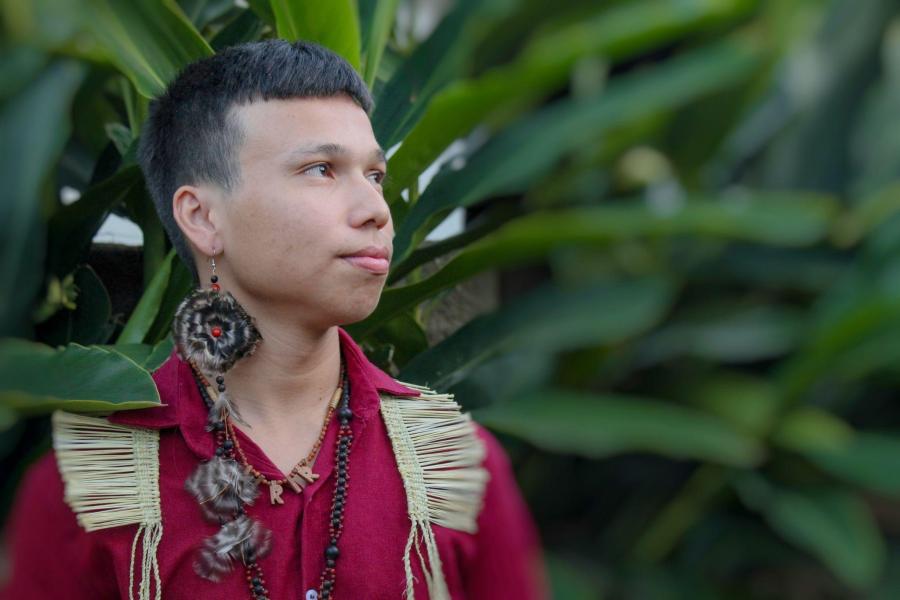Maroons -- descendants of escaped slaves -- still form distinct peoples (sometimes, "states within a state") in several parts of the western hemisphere. Their situations as minorities within nation-states varies but is everywhere severely threatened -- by multinational logging and mining operations and by other assaults on their territories and cultural identities. This special issue brings together international specialists writing about the situation of Maroons in Brazil, Colombia, Ecuador, French Guiana, Jamaica, and Suriname -- their legal battles, their collective demands, their political and economic struggles, and their hopes for the future.
The English word "Maroon" derives from the Spanish cimarrón -- itself based on an Arawakan (Taino) Indian root. Cimarrón originally referred to domestic cattle that had taken to the hills in Hispaniola, and soon after, to American Indian slaves who had escaped from the Spaniards on that Caribbean island. By the end of the 1530s, the word was being used primarily to refer to Afro-American runaways and already had strong connotations of "fierceness" -- of being "wild" and "unbroken."
Historically, communities formed by Maroons dotted the fringes of plantation America from Brazil to Florida, from Texas to Peru. Usually called palenques in the Spanish colonies and mocambos or quilombos in Brazil, they ranged from tiny bands that survived less than a year to powerful states encompassing thousands of members and enduring for generations or even centuries.
Planters generally tolerated petit marronage -- truancy with temporary goals such as visiting a friend or lover on a neighboring plantation. But in most slave-holding colonies, long-term, recidivist Maroons were subjected to the most brutal punishments -- amputation of a leg, castration, suspension from a meathook through the ribs, slow roasting to death -- with such punishments actually written into law. Marronage on a grand scale, with individual fugitives banding together to create communities, struck directly at the foundations of the plantation system, presenting military and economic threats that often taxed the colonists to their limits. Maroon communities, hidden near the fringes of the plantations or deep in the forest, periodically raided plantations for firearms, tools, and women, often permitting families formed during slavery to be reunited in freedom.
In many cases, the beleaguered colonists were eventually forced to sue their former slaves for peace. In Brazil, Colombia, Cuba, Ecuador, Hispaniola, Jamaica, Mexico, Panama, Peru, Suriname, and Venezuela, for example, the whites reluctantly offered treaties granting Maroon communities their freedom, recognizing their territorial integrity, and making some provision for meeting their economic needs, in return for an end to hostilities toward the plantations and an agreement to return future runaways. Of course, many Maroon societies were crushed by massive force of arms, and even when treaties were proposed, they were sometimes refused or quickly violated. Nevertheless, new Maroon communities seemed to appear almost as rapidly as the old ones were exterminated, and they remained, from a colonial perspective, the "chronic plague" and "gangrene" of many plantation societies right up to final emancipation.
The initial Maroons in any New World colony hailed from a Wide range of societies in West and central Africa -- at the outset, they shared no major aspects of culture, including language. Their collective task, once off in the forests or mountains or swamplands, was nothing less than to create new communities and institutions, largely via a process of inter-African cultural syncretism. Those scholars, mainly anthropologists, who have examined contemporary Maroon life most closely seem to agree that such societies are often uncannily "African" in feeling but at the same time largely devoid of directly transplanted systems. However African in character, no Maroon social, political, religious, or aesthetic system can be reliably traced to a specific African ethnic provenience; they reveal rather their syncretistic composition, forged in the early meeting of people of diverse African, European, and Amerindian origins in the dynamic setting of the New World. With a rare freedom to extrapolate ideas from a variety of African societies and adapt them to changing circumstance, Maroon groups included (and continue to include today) what are in many respects at once the most meaningfully African and the most truly "alive" and culturally dynamic of all Afro-American cultures.
During the past several decades, anthropological fieldwork has underlined the strength of historical consciousness among the descendants of these rebel slaves and the dynamism and originality of their cultural institutions. Meanwhile, historical scholarship on Maroons has flourished as new research has done much to dispel the myth of the docile slave. Marronage represented a major form of slave resistance, whether accomplished by lone individuals, by small groups, or in great collective rebellions. Throughout the Americas, Maroon communities stood out as a heroic challenge to white authority -- as the living proof of the existence of a slave consciousness that refused to be limited by the whites' conception or manipulation of it. It is no accident that throughout the Caribbean today, the historical Maroon -- often mythologized into a larger-than-life figure -- has become a touchstone of identity for the region's writers, artists, and intellectuals; the ultimate symbol of resistance and the fight for freedom.
This issue of the CSQ is designed to bring the history and current situation of Maroons to a broader public and to enlist solidarity and support for their ongoing efforts to secure a future as proud and independent peoples within often indifferent or hostile nation-states.
References & further reading
Agorsah, E.K., Ed. (1994). Maroon Heritage: Archaeological, Ethnographic and Historical Perspectives. Kingston, Jamaica: Canoe Press.
Duharte Jiménez, R. (1992). Rebeldía esclava en el Caribe. Xalapa, Mexico: Gobierno del Estado de Veracruz.
Heuman, G., Ed. (1982). Out of the House of Bondage: Runaways, Resistance and Marronage in Africa and the New World. London: Frank Cass.
Price, R., Ed. (1996). Maroon Societies: Rebel Slave Communities in the Americas (3rd edition). Baltimore: Johns Hopkins University Press.
Reis, J.J. & Gomes, F. dos Santos, Eds. (1996). Liberdade por um fio: Historia dos quilombos no Brasil. S...o Paulo: Companhia das Letras.
Article copyright Cultural Survival, Inc.



